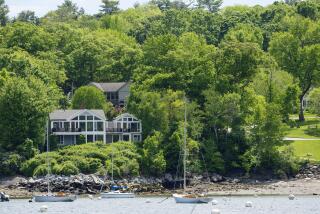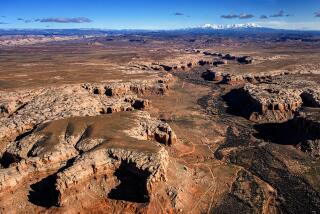Maine’s Wilderness Ways Besieged by New ‘Kings’
- Share via
TOWNSHIP T3 R13, Maine — Chris Nash, a Boston-area shopping center developer, wanted his children to know the great unpaved wilderness. So he bought a 2,255-acre chunk for them.
Here in the vast forests of northern Maine, he paid $880,000 last year for a personal retreat in a place so wild it is nameless. The neighbors are moose, bear and coyote. Some locals call such retreats “wilderness kingdoms.”
Nash’s future lodge will look across Chesuncook Lake at 5,271-foot Mt. Katahdin, where hikers trudge the northernmost steps of the Appalachian Trail. When the wind and screeching ospreys are quiet, you can hear the stillness on the grassy shore of the 20-mile-long lake.
“You look down the third-largest lake in Maine, and you see no houses . . . and no lights--and you never will,” exults Nash.
“Never” may be coming quickly to the North Woods. Over the last 10 years, Maine’s woodlands have been bought and sold at a startling pace, changing attitudes in the heart of the greatest stretch of wild country left in the eastern United States.
This land rush has forced conservationists to improvise an experiment in a place largely hostile to classic forms of wilderness preservation. They are molding conservation to the culture of the North Woods, where private ownership and working land prevail.
The 26-million-acre Northern Forest--a territory almost the size of Pennsylvania--spans central New York state and stretches of Vermont and New Hampshire. But no less than 58% falls within northern Maine. Though mostly wild, the forest lies within a day’s drive of New York City; it is a neighbor to 70 million people.
Large tracts are already protected in New York’s Adirondack Park and in the Green and White Mountain national forests of Vermont and New Hampshire. Up to 90% of the potential future conservation land, according to preservation groups, lies in the North Woods of Maine.
Those woods are a world of rushing rivers, glassy ponds, and spruce and fir spires that stretch in jagged lines to the horizon. Many townships are designated only by number, having no permanent human presence. Fewer than 500,000 people live in the northern two-thirds of Maine.
In a long and respected North Woods tradition, the public is still allowed on most private land to hike, fish, ride snowmobiles, hunt and even camp. Corporate owners have formed a joint managing body that charges daily user fees. The checkpoints look like ranger stations.
But a new pattern is developing in the forest.
More than a quarter of the Maine woods’ 15 million acres has changed hands in the last three years, largely through mergers, mill closings and land sales by lumber and paper producers, according to Maine’s chapter of the Nature Conservancy.
“The sales and amount of acreage that is changing hands are a whole lot more than ever happened,” said Charles Levesque, who headed a regional study group known as the Northern Forest Lands Council.
To be sure, some land has simply been reshuffled among timber and paper companies. They still dominate the remote forest with their gravel logging roads, loaded-down trucks and smoky mills.
But many recent buyers are newcomers, often from out of state. They are looking for investment income from timber sales--without the bother of mill ownership. Or they want somewhere beautiful to build a vacation home. They are turning the working forest into a more valuable commodity: real estate.
“We’ve got millions of acres in the backyard of New England that we’d sort of forgotten,” said conservationist Jym St. Pierre, who oversees the Maine chapter of Restore the North Woods. “Now everybody’s scrapping for a piece of it.”
Sensing an extraordinary opportunity in a place that shaped writer Henry David Thoreau’s wilderness philosophy, conservation groups have helped put 1.1 million North Woods acres into protection since 1992, according to the Northern Forest Alliance, a conservation group.
Before then, little protected land existed in Maine’s North Woods outside Baxter State Park. Even that took private largess. Gov. Percival Baxter bought the land with his own money to establish the park 70 years ago.
The traditional model of conservation at the nation’s Yellowstones and Yosemites--public ownership with no trespassing by private industry--has been largely rejected in the North Woods.
Many here “view ‘park’ as a four-letter word,” said St. Pierre, whose group’s proposal for a North Woods national park has made few inroads.
Most Mainers celebrate their long history of commercial forestry and private ownership.
Many scowl at both government bureaucrats and outsiders--more like Westerners in this way than their New England neighbors in Massachusetts and Connecticut.
And yet outsiders have discovered the North Woods.
Down East magazine, popular with tourists, recently advertised a “mountain kingdom,” the term suggesting size, wealth and local authority all in regal proportion.
Someone was asking $1.3 million for 4,067 acres near Mt. Blue. “Spectacular alpine vistas. Varied wood-life habitats. Only 90 minutes from Portland,” the ad said.
“We’ve had a lot of these kingdom-buyers looking for large parcels of land for family trusts, for investment purposes, and for enjoyment and seclusion. The smarter ones realize these aren’t going to exist forever,” said real estate agent James Trimble of Camden, Maine. He helped Nash buy his kingdom.
Nash put 1,000 of his 2,255 acres back on the market for $950,000. He has terminated the lease for a cabin on his two-mile shoreline, forcing a couple out of their low-cost idyll. They say he paid them $30,000.
Jan Kilbreth, who leased the cabin as a second home with her husband, Walter, said kingdom-buyers don’t understand the North Woods culture. “What they’re violating is this tradition in Maine that’s gone on, this sort of sharing of the wilderness,” she said. “Just being there was all we cared about; we didn’t need to own it.”
Hikers, hunters, fishermen, campers and others worry that kingdom-owners will put up fencing and post no-trespassing signs. One kingdom-buyer, cable television executive John Malone, bought up land encircling a popular fishing lake in northwestern Maine. Information technology executive Richard Brown put together 20,000 acres along Moosehead Lake.
Like many native Mainers, David Powers, who has worked at an East Millinocket paper mill for 28 years, is uneasy. He has witnessed the advent of international competitors, mill shutdowns and other changes in the North Woods. The deer hunting, ice fishing and snowmobiling still appeal to him.
“When private owners start limiting where you can go, I feel things are going to change again,” he said at Poor Boy’s Tavern across the street from the mill. The bar’s sign shows a man in denim, presumably a logger or mill worker, with his empty pockets turned inside out.
Investor groups now own about 15% of Maine’s timberland, up from 1% in 1993, according to the Maine Forest Service. The traditional industrial ownership is down from 46% to 30%.
One of the biggest investor entities is Boston-based Hancock Timber Resource Group, a unit of John Hancock Financial Services. Hancock Timber spokesman Bob Sundmacher says they help conserve wild land by perpetuating forestry, keeping out development. But many conservationists complain that kingdom-buyers and investment groups are inflating the cost of conservation land for public and nonprofit agencies.
More like fiefdoms than kingdoms, vacation homes are also spreading in the North Woods. For instance, in largely untouched Upper Enchanted Township, the shores of Grace Pond near the Quebec border were carved into lots of about 40 acres for development.
“The development tends to be in very special places: beautiful lakes or hillsides,” said John Williams, director of Maine’s Land Use Regulation Commission, which controls development in the North Woods.
Locals universally refer to the agency by its suspicious-sounding acronym, LURC. Out-of-state conservationists--people “from away,” in the Maine idiom--warrant the same wariness. “I don’t think people who aren’t even from here . . . should have any say in what happens in the woods up here,” said paper mill worker Rick Spearrin.
St. Pierre, of Restore the North Woods, knows the attitude well as a native Mainer himself. Still, faced with fragmenting forest ownership, his group put forward a grand proposal in 1994: a 3.2-million-acre North Woods national park, second in size only to Death Valley within the lower 48 states.
“This is really the only place I’m aware of in the Lower 48 where you could create an Alaskan-scale national park and not have to . . . displace a single town,” St. Pierre said.
But the idea won little political backing. “That proposal scares the socks off people in Maine. They figure, ‘Oh, my gosh, it’s going to take land out of timber production. We’re going to lose our jobs. It’s going to close the land to hunting,’ ” said Robert Kimber, a native Mainer who backs the park idea.
Looking for a middle way, conservationists in nonprofit and public agencies have paid owners of private land to forgo development. Much of this land has stayed in use for both timber-cutting and recreation.
Such conservation easements, as they are known, have rarely reached such grand proportions. The West Branch project, which borders Nash’s kingdom and encompasses rapids of the Penobscot River, is expected to cover 656,000 acres once completed, an area almost the size of Rhode Island.
In the view of many conservationists, loggers have too often ravaged the forest by over-cutting, choking rivers with silt and polluting ponds with runoff of herbicides meant to keep down unprofitable trees.
But North Woods conservation has forged compromise here too. The independent Forest Stewardship Council sets lumbering standards that help woodlands replenish themselves and protect wildlife and water quality. Some lumber retailers, including Home Depot, give preference to the FSC label.
Appalachian Trail hiker Leslie Mass, 60, of Powell, Ohio, is glad to be in Maine. In busier New Hampshire, she said, hiking Mt. Washington with so many others had felt like riding “a conveyor belt.”
So she lays down her walking stick, hangs sweaty socks over a branch and fires up a camp stove beside a simple shelter. Two hares streak back and forth, hunting stray morsels in the flickering light.
In some ways, she sees the world as a traditional conservationist: We must protect more wilderness. Owners ought to be stewards.
But, at the end of today’s trail, even she moderates her views.
“I understand that people have to have jobs, and they have to have vacations,” she said. “And we have to share the land.”
More to Read
Sign up for The Wild
We’ll help you find the best places to hike, bike and run, as well as the perfect silent spots for meditation and yoga.
You may occasionally receive promotional content from the Los Angeles Times.






